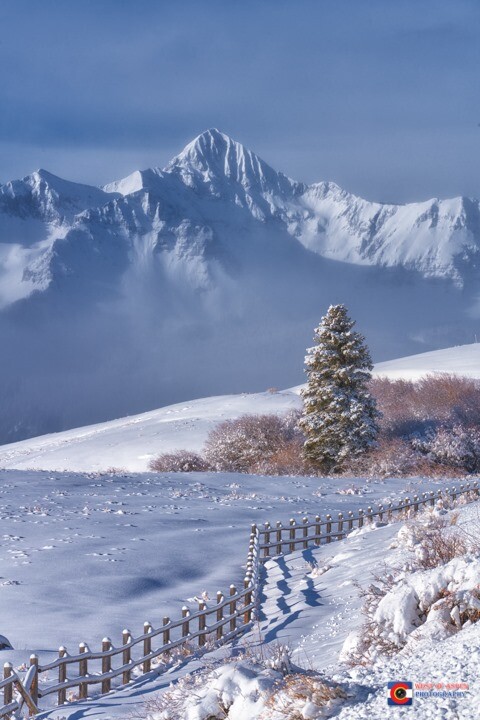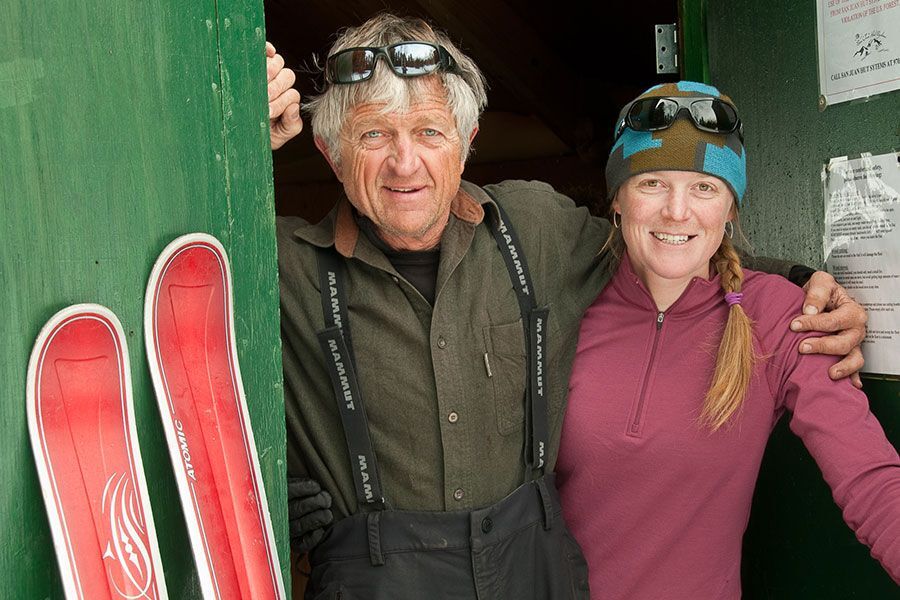The first thing Joe Ryan thought when he heard that a man fell more than 2,000 feet down Wilson Peak Tuesday was, “How can somebody survive that?”
But of all people, he’d know.
See, by some bout of terrible irony plus a mind-boggling amount of luck, history essentially mirrored itself on that mountain, almost exactly seven years apart.
On April 20, 2021, anunidentified 37-year-old man from New Mexico fell from the top of the steep, rugged north face of Wilson Peak, a 14,017-foot mountain near Telluride. Few, if any, people can say they know exactly what that would feel like. But back up a few years to April 24, 2014, and you’d see Ryan’s ski binding come loose near the same summit and his helpless body careening down the same mountain face. Along the way, Ryan said he hit rocks, cracked his helmet, and “ran out of gravity” at 11,300 feet according to a friend’s GPS, about 2,700 feet below the summit.
Despite what seemed like certain death for both men, they not only survived but were out of the hospital within a couple days.
“I didn't know how I didn’t get killed,” Ryan said. “Two people falling down there without getting killed is beating the odds tremendously.”

Joe Ryan recalls his fall: ‘Just unbelievable'
Ryan’s binding had a recall and he found out far, far too late.
On the top of Wilson Peak, he was stomping into it, wondering why it wasn’t catching correctly. Admittedly, the then-64-year-old said he wasn’t really looking at the binding, and was more focused on the 50-plus-degree slope before him.
Wilson Peak is not for the faint of heart. Like many other 14ers in the San Juan Mountains, it’s beautiful but particularly steep and rugged, and the north face has narrow couloirs that are about 20 feet wide in the spring. There’s “a lot of verticality underneath your feet” up there, Ryan said.
Two friends, Brad Johnson and Eric Ming, had joined him and as he continued to work to get his heel into his left binding, Johnson flew down the chute. Ryan was frustrated and tired — the trio had started the hike up at 2 a.m. and it was now 8 a.m. and an equipment problem was the last thing he wanted to deal with.
“So, I pick up my ski and try to slam a piece of the binding back in with the palm of my hand, instead of really assessing what was going on,” he said. “I had a malfunctioning binding — I didn't realize it. I did that a couple of times — I'd slam it back into the binding. And then I thought 'OK, I clicked in. Here we go.'”
He made the first turn and the binding immediately blew out.
Ryan fell forward, did a full somersault, came out of his skis and did another somersault. Where experienced skiers know to swerve left to get on a snow ramp, Ryan’s body plunged straight ahead, right at the cliffs, smashing into rocks along the way and cracking his helmet.

He estimated he was falling anywhere between 70 and 100 miles per hour.
“They knew I was dead,” Ryan said of his two friends. “I mean, both these guys have seen a lot of dead climbers in their time climbing mountains, as I have. And there's no way you take a fall like that without being decapitated, dismembered, etc. Because you're just flying, smashing into rock on the sides of the gully. Just unbelievable.”
Per Johnson’s GPS, Ryan finally stopped around 11,300 feet. By the time Johnson reached Ryan, he saw he was unconscious, but still breathing, and he quickly called for help and a helicopter was dispatched to the area.
“A paramedic got there and then I kind of woke up and they said I was very combative and wanted to get my skis and keep skiing,” Ryan said he later learned.
The paramedics ended up giving him a shot of fentanyl and another drug Ryan couldn’t remember. But it knocked him out, while also erasing his recent memory, for better or worse. The last recollection he can still grasp is the bindings problem on the summit. But nothing of the fall.
(To recreate what it must have been like, Ryan says he wants to tape a GoPro to a soccer ball and launch it off the peak.)
In the hospital, he was treated for an injured ACL, MCL and three other cruciate ligaments in his left leg. He had a tibial plateau fracture in his left knee. Four ribs broke in his upper right chest, collapsing his right lung. His right shoulder scapula was “just shattered,” he said, and he had a basal skull fracture.
“And then the rest of the body was just a bruise,” he said.
For reasons he still doesn’t quite understand, he was released from the hospital just two days after the fall. He said he doesn’t think he woke up until about four days after that, with no memory of his time in the hospital. Despite the treatment he had there, he’d later go to an orthopedic surgeon with knee pain and would learn that his ACL and MCL had snapped, and his tibia plateau was fractured.
But he was back to skiing, with a brace, by the following winter.

Ryan wouldn’t learn until later that the binding he’d worn that fateful day had been recalled five months prior to his fall. To add insult to injury — “a cosmic joke,” as he put it — the recall notice flyer showed a diagram of the binding’s malfunction superimposed on a mountain background. And not just any mountain — Wilson Peak.
“And there's the arrows pointing to the malfunctioning recall binding, and there's a mountain that I fell right down the chute of,” Ryan said, laughing. “It was just too much.”
But just enough to share with the company.
After his recovery, he called them to share the story of his problems with the bindings and the consequent fall.
“You got to hear his jaw drop on the desk: ‘Oh my god, we're getting sued,’” he said of the customer service employee.
But Ryan assured the man he wasn’t the “suing kind,” adding that nobody forced him to go skiing on that peak that day. Still, the company offered him free skis, poles, bindings and boots, which Ryan happily accepted.
This past season, he skied 10 to 15 peaks above 13,000 feet, he said. The incident surely hasn’t kept him away from the mountains. Along with his daughter, he still runsSan Juan Huts Systems, which connects backcountry mountain huts for adventurers traveling by foot, bike and skis.
The memories of his fall came rushing back this week as he heard on the radio that a skier had fallen on the same face of Wilson Peak on Tuesday. Ryan’s speed descent record on the mountain — a long-standing joke of his — may have had a challenger.
“Of course, I wish the other fella that fell the best recovery,” Ryan said. “I hope he doesn't have any sustaining injuries for a long time. And I would love to talk with him and compare notes. That would be fun!”
While rare, high-alpine rescues are a massive undertaking
There’s no doubt that the two men’s falls should have been deadly. Several mountains, Wilson Peak included, around Colorado have become scenes of treacherous rescues and tragic recoveries.
Susan Lilly, public information officer with San Miguel County Sheriff’s Office, said those missions aren’t common, but when they do happen, it’s a big deal.
“It's treacherous terrain. It's for serious backcountry skiers,” Lilly said. “They typically go with intent to have a spectacular experience, and most of them, by and large, do. It's the ones that either make a mistake or miscalculate or they don't make a mistake, and something happens with nature.”
Maybe it’s hitting a rock, maybe it’s an avalanche, she said.
“But there are things you can control and things you can't, and it's those things in between. ... It's anything that can come get you,” she said. “These guys had the come-get-you moment and lived to tell about it.”
Just last summer, a30-year-old man fell down a steep scree field on Wilson Peak, igniting a complex rescue at about 13,300 feet.
Deputies, Search and Rescue volunteers and @TellurideFPD responded to an "SOS" call received around 11am for an injured male hiker in the Wilson Peak area outside of Telluride. Thanks to Mountain Blade Runner and Careflight who are assisting with the mission. pic.twitter.com/xzB3itciVU
— San Miguel Sheriff (@SheriffAlert) September 26, 2020
Between deep snow and howling, bone-chilling wind, these mountains invite far fewer people in the colder seasons than the summertime. But sometimes, that’s exactly what an adventurer seeks.
If you plan to hike one of these mountains — as well as many of the state’s 13ers — in the winter, make sure to plan ahead for the forecast,check the Colorado Avalanche Information Center’s website, and go with a buddy or tell somebody where you’re headed and when you plan to return.
Here are a few preparation and packing tips for your next winter mountain adventure:
- Bring lots of layers, ranging from thin base layers to a shell jacket that will keep rain, snow and wind away from your core
- Bring goggles or secure, sturdy sunglasses. Snow blindness isn’t uncommon if it’s a sunny day.
- Wear sunscreen
- Ensure your whole body is covered from the elements, including your fingers, nose, lips and forehead to avoid frostbite and windburn
- Keep food and water in a place where it won’t freeze (ex. inner jacket pocket)
- As with any outdoor adventure, make sure you know the route well and carry a physical map. Cell service can be unreliable
- Do your research ahead of time for the kind of terrain you’ll be on: Do you need microspikes? Crampons? Snowshoes?
- And likewise, if you’replanning to travel in avalanche terrain, ensure you have all necessary equipment and know how to use it in an emergency.Take an avalanche course ahead of time if you’re able
- 14ers.com is a popular website to learn about current conditions on the state’s 14ers and 13ers. The website also features summer and winter routes. It also has an app to take the information on the go
- Hiking in snow is much slower than hiking on the dry ground, so prepare for a long day





